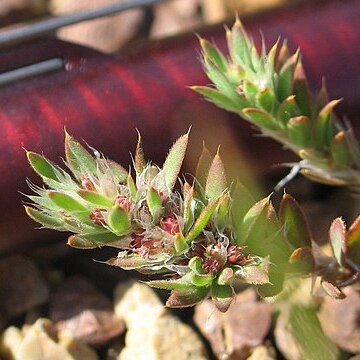Herb, perennial, with woody tap root, ±pubescent. Stems prostrate, much-branched from base, 15–35 cm long; internodes often glabrous. Leaves sessile, ciliate to adpressed-pubescent, elliptic-oblong to oblanceolate, acute, mucronate, rather thick, 4–10 mm long, 1.5–2.5 mm wide; stipules acuminate, often clasping internodes, to 6 mm long, 2.3 mm wide. Inflorescence densely congested with age, ±concealed by foliage; bracts acuminate, translucent, usually not concealing flowers. Flowers 1.7–1.8 mm long; pedicels very short or absent. Calyx pale yellowish or greenish brown, usually sparsely pubescent near sepal tip, occasionally glabrous. Sepals 1.2–1.4 mm long, oblong, weakly cucullate, with narrow, membranous margin; awn short, 0.4–0.6 mm long, slender, erect or suberect, spreading at c. 10° to axis. Petals absent. Styles 2. Achene c. 1.3 mm long, subglobose. Seeds 1–1.2 mm diam., reddish brown, ±glossy, finely punctate.

